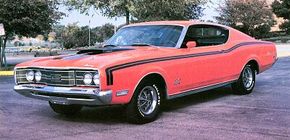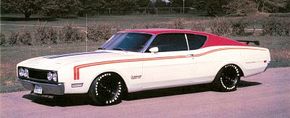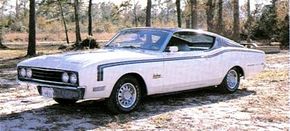Key Takeaways
- The 1968-1969 Mercury Cyclone GT transformed into a Torino clone following Ford's lead, doubling sales but not reaching previous highs.
- Notable features include long-profiled fastback design, various V-8 engine options and a performance/handling GT package.
- The 1969 model saw GT demoted to an appearance option group, with CJ trim offering a standard 428-cid V-8 and impressive performance stats.
As the 1968-1969 Mercury Cyclone GT came along, the Mercury boys, once again following the lead of Ford, turned their sinking Cyclone into a Torino clone. Sure enough, sales just about doubled. Unfortunately, the 1967 total had sunk so low that even twice that figure wasn't likely to induce euphoria.
Most of the attention went to the rakish, long-profiled fastback 1968 Mercury Cyclone GT with its vast rear quarter reaching back in a straight line from the roof. Bodyside striping stretched from headlight to tail, kicking up at the quarter window to accent the illusion of endless length on the GT edition. Another stripe flowed between GT wheel openings, helping to spotlight its graceful contours.
Advertisement
Though less dramatic, the formal-roof notchback hardtop -- also offered in base and Cyclone trim -- displayed a pleasing shape. Evidently, however, it was not pleasing enough, as it would fade away after 1968.
Both versions gave the impression of added size, but wheelbases were unchanged at 116 inches. The notchback's increase wasn't entirely illusory; it measured three inches longer than the fastback. Either 1968 Mercury Cyclone GT model started at $2,936, nearly a hundred bucks less than a 1967 GT hardtop.
Beneath the hood of both base and GT Cyclones sat a 302-cid V-8, delivering 210 horsepower and driving a three-speed manual gearbox. Checking the option list brought a more potent 302 (230 bhp), or a Marauder 390 carrying four-barrel carburetion and 10.5:1 compression -- along with a muscular 325 bhp. Settling for a 390 with two-barrel and 9.5:1 compression meant only 265 horses. Any of those mills could be ordered with Select-Shift Merc-O-Matic or a four-speed manual box.
Topping the list was a 427-cid V-8, detuned to a still-sizable 390 horsepower. Also available in the Cougar GT-E, the 427 came only with Merc-O-Matic and included heavy-duty cooling. By the time the model year got rolling, Mercury announced deletion of the 427 as a Cyclone option. No problem. Availability of the Cobra Jet 428 with its 335-bhp purring away was almost as good.
1968 Mercury Cyclone GT bucket seats were upholstered in Comfort-Weave vinyl, able to "breathe." Higher-rate springs and shocks, and large-diameter stabilizer, were part of the performance/handling GT package. Turbine-style wheel covers further augmented the image of ready-to-roll muscle. So did the down-to-basics black-out grille perched behind a trio of simple horizontal bars.
A few dollars more bought a tachometer to check out the action. More yet: an AM radio with Stereo-Sonic tape, or a Whisper-Aire conditioner. Styled steel wheels could be ordered for $96, but wire wheel covers quickly left the option list.
Advertisement


